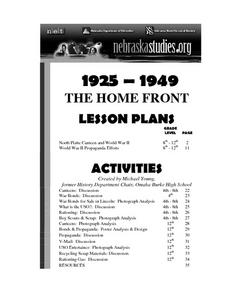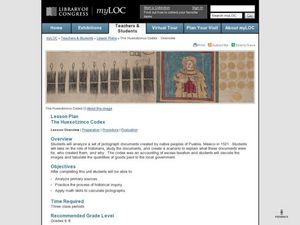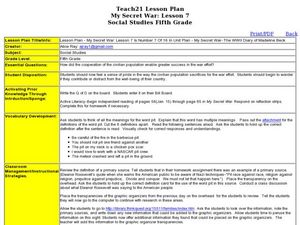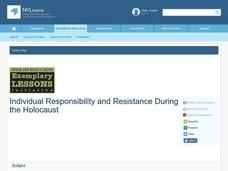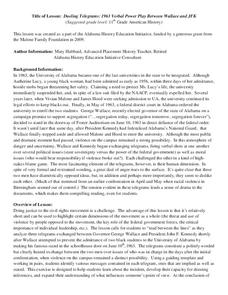Curated OER
North Platte Canteen and World War II
Students employ primary resources to investigate the rise and decline of a canteen in World War II. The significance of volunteerism and the use of the railroad for troop transportation are examined.
Curated OER
A House Divided: Slavery in the United States
Students explore the history of the United States and slavery. In this slavery lesson plan, students view primary sources, complete journal writing, view videos, and answer short answer questions.
Curated OER
Lesson PlanThe Huexotzinco Codex
Learners examine primary sources that include pictographs from Puebla, Mexico. In this Huexotzinco Codex lesson, students perform historical analysis as they investigate the codex as they make inferences and draw conclusions about taxes...
Curated OER
Visions in the Dust: A Child's Perspective of the Dust Bowl
Learners examine primary source material of the Depression to correlate the fictional text "Out of the Dust" with actual visual, auditory, and manuscript accounts as found in the American Memory collections.
Curated OER
Indian Boarding Schools
Students research government-run American Indian boarding schools. In this American Indian history lesson plan, students analyze primary documents to develop an understanding of the forced acculturation of American Indians through...
Curated OER
My Secret War: Lesson 7
Fifth graders discuss the cooperation of the civilian population during World War II. In this social studies lesson, 5th graders read My Secret War and complete reflection strips over the reading. Students discuss primary sources.
Curated OER
The Most American Thing in America: The Chautauqua
Young scholars explore the Chautauqua movement. In this Pennsylvania history lesson, students use primary documents to explore what the Chautauqua was and how it made a difference in the American way of life.
Curated OER
Dispute Over Slavery in Kansas Territory
Young scholars analyze primary sources on slavery from Kansas Territory. In this Civil War instructional activity, students evaluate the antislavery and pro-slavery arguments and summarize key points. Young scholars write a persuasive...
Curated OER
The Garber Family Letters: Recreating 19th-Century Family
Young scholars interpret primary sources and recreate the story of the Garber family.
Curated OER
World War II
Young scholars analyze primary sources (photographs) for evidence of American military technology during WWII. They debate the use of the Atomic Bomb. Students view the Rosenthal image. They discuss the image in detail.
Curated OER
Language and Runaway Slave Ads
High schoolers interpret historical evidence presented in primary resources. In this fugitive slave lesson, students research and analyze fugitive slave advertisements from Virginia newspapers.
Curated OER
A State Divided - Maryland in the Civil War Era
Young scholars use primary sources to see how Maryland was a divided state during the time leading up to the Civil War. In this Civil War lesson plan, students go over vocabulary, and look at maps that show the division of opinions of...
Curated OER
Sorting the Loyalist Documents
Students organize the Canadian Loyalist primary source documents and add more information to their primary source document concept maps.
Curated OER
The Mystery of History - Original Sources
Students examine and discuss the differences between primary and secondary sources. They brainstorm examples of each, locate examples of primary and secondary sources on the Internet, and identify three primary sources from home.
Curated OER
A Hoosier Perspective on the March to the Sea: The Diary of William Miller
Eighth graders take a closer look at Sherman's March to the Sea. In this American Civil War lesson, 8th graders analyze the diary entries of William Miller. Discussion questions are included with the entries. Students create illustrated...
Curated OER
Education, Design & Empowerment: Part One
Learners consider the connection between poverty and education. In this language arts and social studies lesson plan, students research primary and secondary sources in order to explore the relationship between education and poverty.
Curated OER
Women in the WWII Workplace: Propaganda vs. Reality
In this propaganda instructional activity, students analyze posters of Rosie the Riveter and respond to 4 short answer questions about the poster and World War II realities.
Curated OER
A Midwestern Runaway Remembers the CCC (with text supports)
In this Civilian Conservation Corps worksheet, students read a narrative from a member of the corps and then respond to 3 short answer questions based on the narrative.
Curated OER
The American Revolution: An Electronic Field Trip
Learners examine basic facts of American Revolution, conduct Internet research to explore major events, choose topic and evaluate data, and write letters to or from fictitious person who could have been involved in that event during...
National History Day
“War Is Hell. We Know it Now.” American Soldiers in the Meuse-Argonne Offensive
Understanding the soldier's experiences during World War I sometimes takes a newscast. Learners see the importance of understanding multiple points of view with a newscast project surrounding the Meuse-Argonne Offensive. Compare and...
Mr. Roughton
Late Middle Ages Dossiers
Young detectives are given the "clues" to investigate whether King John should be remembered as a poor ruler of England, particularly in comparison in King Richard. They analyze historical informational texts and work in...
Curated OER
Individual Responsibility and Resistance During the Holocaust
Young scholars examine what obstacles hinder resistance, what types of resistance are possible and how different individuals resisted Nazi oppression. They examine primary source documents related to the Holocaust and analyze various...
Curated OER
Triangular Trade
This activity has it all, primary source documents, an interactive trade game, clear teacher background information, and sailing to the West Indies chance cards. You will play, trade, and live out the experiences of early colonists in...
Alabama Department of Archives and History
Dueling Telegrams: 1963 Verbal Power Play Between Wallace and JFK
Information, inferences, and innuendos. Text and subtext. Class members examine telegrams exchanged between President John F. Kennedy and Alabama Governor George Wallace, studying both what is stated and what is implied by the...


